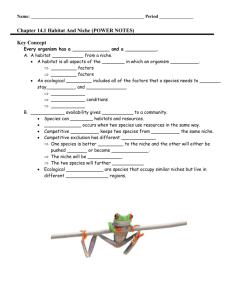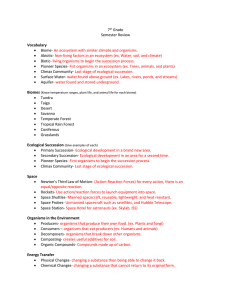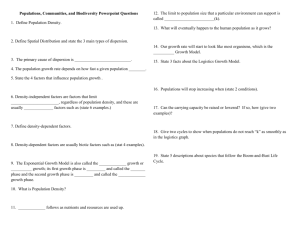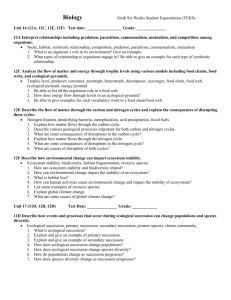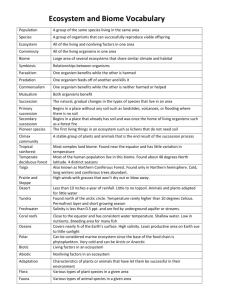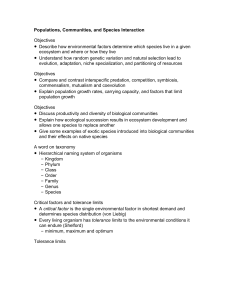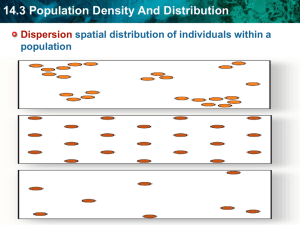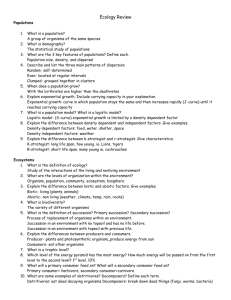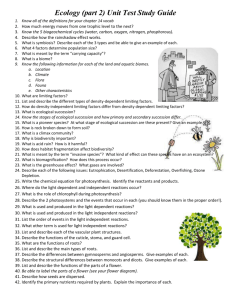Science Olympiad Ecology Competition 2009
advertisement
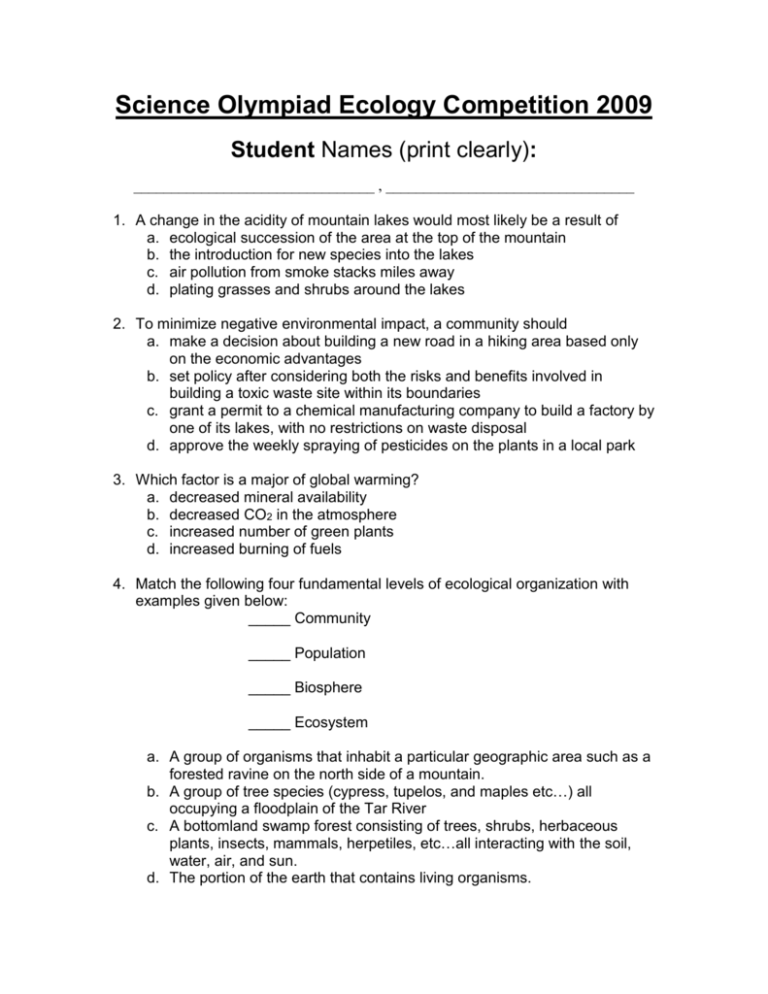
Science Olympiad Ecology Competition 2009 Student Names (print clearly): ________________________________ , _________________________________ 1. A change in the acidity of mountain lakes would most likely be a result of a. ecological succession of the area at the top of the mountain b. the introduction for new species into the lakes c. air pollution from smoke stacks miles away d. plating grasses and shrubs around the lakes 2. To minimize negative environmental impact, a community should a. make a decision about building a new road in a hiking area based only on the economic advantages b. set policy after considering both the risks and benefits involved in building a toxic waste site within its boundaries c. grant a permit to a chemical manufacturing company to build a factory by one of its lakes, with no restrictions on waste disposal d. approve the weekly spraying of pesticides on the plants in a local park 3. Which factor is a major of global warming? a. decreased mineral availability b. decreased CO2 in the atmosphere c. increased number of green plants d. increased burning of fuels 4. Match the following four fundamental levels of ecological organization with examples given below: _____ Community _____ Population _____ Biosphere _____ Ecosystem a. A group of organisms that inhabit a particular geographic area such as a forested ravine on the north side of a mountain. b. A group of tree species (cypress, tupelos, and maples etc…) all occupying a floodplain of the Tar River c. A bottomland swamp forest consisting of trees, shrubs, herbaceous plants, insects, mammals, herpetiles, etc…all interacting with the soil, water, air, and sun. d. The portion of the earth that contains living organisms. For questions 5-9 choose from the names of the biomes below. Names may be used once, more than once, or not at all. a. Tropical rain forest b. Desert c. Savanna d. Temperate grassland e. Tundra f. Taiga 5. 6. 7. 8. 9. also known as the permafrost average rainfall ~ 25 cm per year characteristic organisms: bison, gazelles, zebras, rhinoceroses preferred habitat of buffaloes (Bison bison) second-largest biodiversified biome in the world 10. Which sequence shows a correct pathway for the flow of energy in a food chain? a. algae snake duck deer b. fungi beetle algae mouse c. grass grasshopper frog snake d. bacteria grass fox owl 11. How is an ecosystem organized, from least to most comprehensive? a. Individual, community, population, biome b. Individual, population, community, biome c. Individual, population, niche, community d. Individual, niche, community, population e. Individual, population, biome, niche 12. Why is energy lost as it moves from producers to primary consumers? a. Saprophytic activity b. Biomass decreases c. Secondary consumers eat primary consumers d. Respiration and metabolic activity e. None of the above 13. Which of the following organisms participate in the nitrogen cycle? a. Denitrifying bacteria b. Chemosynthetic bacteria c. Saprophytes d. All of the above e. None of the above 14. When resources are abundant and the environment is stable, which reproductive strategy is most effective? a. Sexual reproduction, with intense parental care and slow development b. Sexual reproduction, with slight parental care and quick development c. Parthenogenesis d. All of the above e. None of the above 15. Why might growth slow from an exponential rate in a population of sheep? a. Disease b. Lack of space c. Wolves d. All of the above e. None of the above 16. What is a relationship in which two organisms both benefit from their association? a. Symbiosis b. Mutualism c. Commensalism d. Parasitism e. Competition 17. Which is true of ecological succession? a. Pioneer species move into new communities first. b. Climax communities have lower total biomass than preceding communities. c. Species diversity is greatest in the early stages of succession. d. Climax communities shift constantly. e. All of the above 18. Tundra is characterized by a. trees such as beech, maple, and oak b. high biodiversity c. barrenness d. a short growing season following rainfall e. none of the above 19. Which of the following releases carbon dioxide into the atmosphere? a. Animal consumption of producers b. Photosynthesis c. Chemosynthesis d. Bacterial decay e. None of the above 20. In a plains community, the population with greatest biomass would be a. hawks b. foxes c. prairie dogs d. grasses e. beetles 21. Primary producers on earth are a. heterotrophs b. autotrophs c. parasites d. carnivore e. herbivore 22. The Second Law of Thermodynamics predicts that a. energy may be changed from one form into another b. there is a reduction in the amount of free energy every time energy is changed from one form into another c. energy can neither be created nor destroyed d. energy in a black hole is being created e. endergonic reactions will produce more energy than they consume 23. A broad based, pyramid-shaped age structure is characteristic of a population that is a. growing rapidly. b. at carrying capacity. c. stable. d. limited by density-dependent factors. e. shrinking. 24. When needed resources are unevenly distributed, organisms often show a a. density-dependent dispersion pattern. b. clumped dispersion pattern. c. exponential dispersion pattern. d. random dispersion pattern. e. uniform dispersion pattern. 25. A biologist wants to use the mark-recapture method to census a population of desert mice. This will work if a. the mice are territorial. b. the mice become wary of the traps. c. the biologist waits too long before resampling the population. d. the mice deliberately return because the traps contain food. e. none of these above. 26. Changes in the seasons are caused by a. the tilt of Earth's axis toward or away from the sun. b. annual cycles of temperature and rainfall. c. variation in the distance between Earth and the sun. d. an annual cycle in the sun's energy output. e. the periodic buildup of heat energy at the equator. 27. Graylag geese learn to follow their mothers. This is an example of a. habituation. b. operant conditioning. c. altruism. d. imprinting. e. agonistic behavior. 28. Bees can see colors we cannot see, and they can detect minute amounts of chemicals we cannot sense. Unlike many insects, bees cannot hear very well. An ethologist would probably give which of the following as the ultimate explanation for their poor hearing? a. Bees are too small to have functional ears. b. Hearing may not contribute much to a bee's reproductive success. c. If a bee could hear, its tiny brain would be swamped with information. d. This is an example of altruism. e. If bees could hear, the noise of the hive would drive them crazy. 29. The total amount of energy trapped at the first trophic level that is available to the first level of consumers is called a. energy transfers b. gross primary production c. net primary production d. carbon fixation e. energy input 30. The basic pattern of an interaction between two species in which one benefits while the other neither benefits nor is harmed is called a. commensalism b. parasitism c. mutualism d. competition e. neutralism 31. One important component of the carbon cycle is a. molecular oxygen b. molecular ATP c. ammonia d. water e. molecular carbon dioxide 32. Interrelated groups of food chains are known as a a. niche b. food web c. population d. habitat e. none of these 33. The biome which is characterized by coniferous forests, long, severe winters, and a permanent cover of snow is the a. chaparral b. temperate grasslands c. temperate deciduous forest d. tundra e. taiga 34. Primary producers on earth are a. omnivores b. photosynthesizers c. parasites d. carnivores e. herbivores 35. The three principal steps in the nitrogen cycle are a. ammonification, nitrification, and ecological succession b. ammonification, assimilation, and phosphorylation c. ammonification, nitrification, and assimilation d. phosphorylation, hydration, and assimilation e. respiration, decaryboxylation, and quantification 36. Describe the biogeochemical cycles of carbon and nitrogen. Trace these elements from the point of their release from a decaying animal to their incorporation into a living animal. 37. Using an example for each, discuss the following ecological concepts. a) Succession b) Energy flow between trophic levels c) Limiting factors d) Carrying capacity 38. Describe the process of ecological succession from a pioneer community to a climax community. Include in your answer a discussion of species diversity and interactions, accumulation of biomass, and energy flow.
